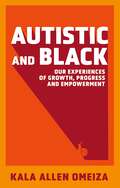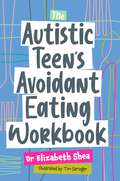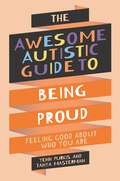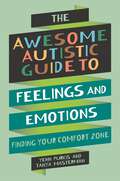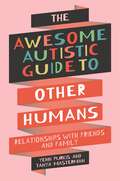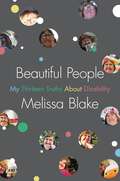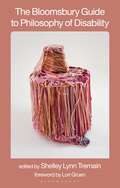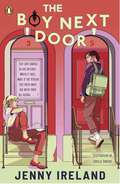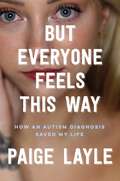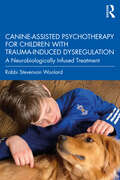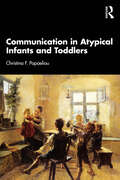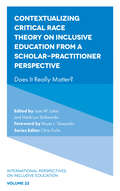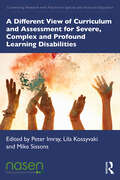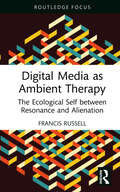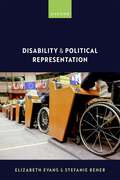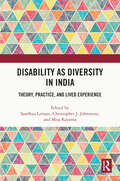- Table View
- List View
Autistic and Black: Our Experiences of Growth, Progress and Empowerment
by Kala Allen Omeiza"It's time we bring forward Black autistic pain points and celebrate the triumphs of ourselves, family members, and organizations that care for these individuals. Through following the real stories of others from around the world, I hope fellow Black and autistic individuals will be empowered to realize that being Black and autistic is enough."In this powerful insight into the lives of Black autistic people, Kala Allen Omeiza brings together a community of voices from across the world, spanning religions, sexuality and social economic status to provide a deep and rich understanding of what it means to be autistic and Black.Exploring everything from self-love and appreciation, to the harsh realities of police brutality, anti-Black racism, and barriers to care, as well as amplifying the voices of the inspiring advocates who actively work towards change, protection, and acceptance for themselves and others, this book is an empowering force, reminding you that as a Black autistic person, you are enough.
The Autistic Teen's Avoidant Eating Workbook
by Elizabeth SheaWhat should I be aware of when trying new foods?Am I ready to change my eating patterns?How can I eat with other people?Food can come with all sorts of challenges - sensory issues, social pressure, loss of control - and so making choices about what foods to eat, and coping with mealtimes can be stressful - especially when other people are involved.If you are neurodivergent and looking to change your relationship with food, this interactive, accessible guide is the perfect companion. You might stick to the same 'safe' foods all the time, be attached to specific mealtime rituals, or struggle to know whether you are hungry or full. This guide will help you recognise the signs of avoidant eating, cope with food related anxieties and manage sensory overload, as well as the particular social stresses of communal eating.With top tips, a progress tracker, quizzes and worksheets, this is an engaging and informative resource for teens and parents alike.
The Awesome Autistic Guide to Being Proud: Feeling Good About Who You Are (Awesome Guides for Amazing Autistic Kids)
by Tanya Masterman Yenn PurkisWelcome to the autistic community! We're very glad you're here!Sometimes it can be difficult to feel proud of who you are. Maybe you feel different from other people or struggle to fit in - there is no need to worry! Yenn, Tanya and a tiny meerkat called Min are here to help you discover how to feel proud to be you.From learning about the autistic community, to finding like-minded friends and connecting with others, this book will give you everything you need to ask the question 'what does it mean to be me?' Learn alongside Min how the special things that make you YOU can also help find your own community.Discover your own strengths, boost your confidence, and learn how to start your journey as an awesome autistic person with the community by your side
The Awesome Autistic Guide to Feelings and Emotions: Finding Your Comfort Zone (Awesome Guides for Amazing Autistic Kids)
by Yenn Purkis Tanya MastermanUnderstanding your feelings and emotions is an incredibly important part of learning to become your most awesome autistic self!Yenn, Tanya and a tiny meerkat called Min are here to help you find out everything you need to know about your feelings and emotions, using tips and tricks they have picked up along the way to help you calm your brain down when it feels overloaded.From anger and worry to sadness and joy, emotions can come in all shapes and sizes with some feeling really big and others feeling much smaller (or even feeling like nothing), this book explores why we experience certain emotions, what they mean and how we can find the ultimate autistic comfort zone!
The Awesome Autistic Guide to Other Humans: Relationships with Friends and Family (Awesome Guides for Amazing Autistic Kids)
by Yenn Purkis Tanya MastermanLet's face it, other humans can be difficult to understand sometimes!There is no need to worry! Yenn, Tanya and a tiny meerkat called Min are here to help you find out everything you need to know about friendships, improving relationships with your family members, and how to deal with disagreements that can arise with the people in your life.Answering the difficult questions like 'What makes a good friend?' and 'Why do adults tell me to do things?' this book gives you helpful tips, tricks, and advice you need to help you understand other humans whilst staying true to your own awesome autistic self!
Beautiful People: My Thirteen Truths About Disability
by Melissa BlakeWell-known disability activist and social media influencer Melissa Blake offers a frank, illuminating memoir and a call to action for disabled people and allies. In the summer of 2019, journalist Melissa Blake penned an op-ed for CNN Opinion. A conservative pundit caught wind of it, mentioning Blake&’s work in a YouTube video. What happened next is equal parts a searing view into society, how we collectively view and treat disabled people, and the making of an advocate. After a troll said that Blake should be banned from posting pictures of herself, she took to Twitter and defiantly posted three smiling selfies, all taken during a lovely vacation in the Big Apple:I wanted desperately to clap back at these vile trolls in a way that would make a statement, not only about how our society views disabilities, but also about the toxicity of our strict and unrealistic beauty standards. Of course I knew that posting those selfies wasn't going to erase the nasty names I'd been called and, the chances were, they would never even see my tweet, but that didn't matter. I wasn't doing it for them; I was doing it for me and every single disabled person who has been bullied before, online and in real life. When people mock how I look, they're not just insulting me. They're insulting all disabled people. We're constantly told that we're repulsive and ugly and not good enough to be seen. This was me pushing back against that toxic, ableist narrative.For the first time, I felt like I was doing something empowering, taking back my power and changing the story. Her tweet went viral, attracting worldwide media attention and interviews with the BBC, USA Today, the Chicago Tribune, PEOPLE magazine, Good Morning America and E! News. Now, in her manifesto, Beautiful People, Blake shares her truths about disability, writing about (among other things): the language we use to describe disabled people ableism, microaggressions, and their pernicious effects what it's like to live in a society that not only isn't designed for you, but actively operates to render you invisible her struggles with self‑image and self‑acceptance the absence of disabled people in popular culture why disabled people aren't tragic heroes Blake also tells the stories of some of the heroes of the disability rights movement in America, in doing so rescuing their incredible achievements from near total obscurity. Highlighting other disabled activists and influencers, Blake&’s work is the calling card of a powerful voice—one that has sparked new, different, better conversations about disability.
The Bloomsbury Guide to Philosophy of Disability
by Shelley Lynn TremainThe Bloomsbury Guide to Philosophy of Disability is a revolutionary collection encompassing the most innovative and insurgent work in philosophy of disability. Edited and anthologized by disabled philosopher Shelley Lynn Tremain, this book challenges how disability has historically been represented and understood in philosophy: it critically undermines the detrimental assumptions that various subfields of philosophy produce; resists the institutionalized ableism of academia to which these assumptions contribute; and boldly articulates new anti-ableist, anti-sexist, anti-racist, queer, anti-capitalist, anti-carceral, and decolonial insights and perspectives that counter these assumptions. This rebellious and groundbreaking book's chapters–most of which have been written by disabled philosophers–are wide-ranging in scope and invite a broad readership. The chapters underscore the eugenic impetus at the heart of bioethics; talk back to the whiteness of work on philosophy and disability with which philosophy of disability is often conflated; and elaborate phenomenological, poststructuralist, and materialist approaches to a variety of phenomena. Topics addressed in the book include: ableism and speciesism; disability, race, and algorithms; race, disability, and reproductive technologies; disability and music; disabled and trans identities and emotions; the apparatus of addiction; and disability, race, and risk. With cutting-edge analyses and engaging prose, the authors of this guide contest the assumptions of Western disability studies through the lens of African philosophy of disability and the developing framework of crip Filipino philosophy; articulate the political and conceptual limits of common constructions of inclusion and accessibility; and foreground the practices of epistemic injustice that neurominoritized people routinely confront in philosophy and society more broadly.A crucial guide to oppositional thinking from an international, intersectional, and inclusive collection of philosophers, this book will advance the emerging field of philosophy of disability and serve as an antidote to the historical exclusion of disabled philosophers from the discipline and profession of philosophy.The Bloomsbury Guide to Philosophy of Disability is essential reading for faculty and students in philosophy, disability studies, political theory, Africana studies, Latinx studies, women's and gender studies, LGBTQ studies, and cultural studies, as well as activists, cultural workers, policymakers, and everyone else concerned with matters of social justice.Description of the book's cover: The book's title appears on two lines across the top of the cover which is a salmon tone. The names of the editor and the author of the foreword appear in white letters at the bottom of the book. The publisher's name is printed along the right side in white letters. At the centre, a vertical white rectangle is the background for a sculpture by fibre artist Judith Scott. The sculpture combines layers of shiny yarn in various colours including orange, pink, brown, and rust woven vertically on a large cylinder and horizontally around a smaller cylinder, as well as blue yarn woven around a protruding piece at the bottom of the sculpture. The sculpture seems to represent a body and head of a being sitting down, a being with one appendage, a fat person, or a little person.
The Boy Next Door
by Jenny IrelandThe new novel by Carnegie Medal nominated author Jenny Ireland. Perfect for fans of Emily Henry and Jennifer Niven. Now she wasn’t Molly Cassidy, St Anne’s pain-in-the-hole princess. She was nine-year-old Molly who was my best friend in the whole world. Nobody had put her in the recovery position. All these people and they’d just left her like that . . . I held her hand until the ambulance came.Finbar and Molly live next door to each other. When they were children, they spent hours and hours together. They were best friends. Until they weren't. Now 18, Fin and Molly move in very different circles. Molly is popular, pretty, dating the most handsome boy in the whole school. Fin has one friend and he's pretty sure he hates his dad and his little sister. At a party one night, though, they're pulled together in a way neither of them expects and then follows a year that will see them experiencing life-changing challenges, friendships, love and everything in between.Praise for Jenny Ireland:'Everything a YA contemporary novel should be: full of warmth, growth, and romance . . . beautifully relatable and a powerful reminder of the importance of empathy' - Paper Lanterns'Romance with substance' - Irish Times
But Everyone Feels This Way: How an Autism Diagnosis Saved My Life
by Paige LayleIn But Everyone Feels This Way, Autism acceptance activist and multi-million-follower TikTok influencer Paige Layle shares her deeply personal journey to diagnosis and living life autistically. It all started out pretty normal: Paige lived in the countryside with her parents and brother Graham. She went to school, hung out with friends, and all the while everything seemed so much harder than it needed to be. A break in routine threw off the whole day. If her teacher couldn't answer 'why?' in class, she dissolved into tears, unable to articulate her own confusion or explain her lack of control. But Paige was normal. She smiled in photos, picked her feet up when her mum needed to vacuum instead of fleeing the room, and did well at school. She was popular and well-liked. And until she had a full mental breakdown, no one believed her when she claimed that she was not okay.Women are frequently diagnosed with autism much later than men, often in their late teens or early twenties. Armed with her new diagnosis, Paige set out to learn how to live her authentic, autistic life, and discovered how autism could be a source of strength. She challenges stigmas, taboos, and stereotypes so that everyone can see themselves authentically. Along the way, her online activism has spread awareness, acceptance, and self-recognition in millions of others.
Canine-Assisted Psychotherapy for Children with Trauma-Induced Dysregulation: A Neurobiologically Infused Treatment
by Robbi Stevenson WoolardThis book provides mental health researchers and clinicians with valuable insight into the pathway that leads from developmental trauma to dysregulation and psychopathology. Incorporating science that explains the impact of early trauma, this book details the theory, mechanisms, and applications of neurobiologically informed canine-assisted psychotherapy, using illuminating case studies that demonstrate the efficacy of the author’s model.
Canine-Assisted Psychotherapy for Children with Trauma-Induced Dysregulation: A Neurobiologically Infused Treatment
by Robbi Stevenson WoolardThis book provides mental health researchers and clinicians with valuable insight into the pathway that leads from developmental trauma to dysregulation and psychopathology. Incorporating science that explains the impact of early trauma, this book details the theory, mechanisms, and applications of neurobiologically informed canine-assisted psychotherapy, using illuminating case studies that demonstrate the efficacy of the author’s model.
Communication in Atypical Infants and Toddlers
by Christina F. PapaeliouThis book presents a comparative review of the latest studies and data on prelinguistic communication and early semantic development in autism spectrum disorder (ASD), Williams syndrome (WMS), attention-deficit/hyperactivity disorder (ADHD), and early language delay. Papaeliou offers a critical analysis of the literature, compares key theoretical approaches, and interprets data on development in atypical populations.A fruitful synthesis of theory and research reveals that, instead of cognitive deficits, the core feature of these neurodevelopmental disorders consists of deficits in the ability for self- and intersubjective coordination, which adversely affects early interactions and, consequently, the emergence of language. The book composes fragmentary proposals on the role of rhythm disruptions in different conditions, setting out the idea that disruption in interactional synchrony is a connecting thread through neurodevelopmental disorders which show high prevalence or high comorbidity rates. Papaeliou identifies distinct communicative patterns characteristic of each disorder and puts forward a unifying theory for interpreting data on early communication and language development in atypical populations.This is ideal reading for psychologists, psycholinguists, psychiatrists, paediatricians, speech therapists, and special educators. Students in developmental psychology and anyone interested in understanding the research behind typical and atypical development will also benefit from this text.
Communication in Atypical Infants and Toddlers
by Christina F. PapaeliouThis book presents a comparative review of the latest studies and data on prelinguistic communication and early semantic development in autism spectrum disorder (ASD), Williams syndrome (WMS), attention-deficit/hyperactivity disorder (ADHD), and early language delay. Papaeliou offers a critical analysis of the literature, compares key theoretical approaches, and interprets data on development in atypical populations.A fruitful synthesis of theory and research reveals that, instead of cognitive deficits, the core feature of these neurodevelopmental disorders consists of deficits in the ability for self- and intersubjective coordination, which adversely affects early interactions and, consequently, the emergence of language. The book composes fragmentary proposals on the role of rhythm disruptions in different conditions, setting out the idea that disruption in interactional synchrony is a connecting thread through neurodevelopmental disorders which show high prevalence or high comorbidity rates. Papaeliou identifies distinct communicative patterns characteristic of each disorder and puts forward a unifying theory for interpreting data on early communication and language development in atypical populations.This is ideal reading for psychologists, psycholinguists, psychiatrists, paediatricians, speech therapists, and special educators. Students in developmental psychology and anyone interested in understanding the research behind typical and atypical development will also benefit from this text.
Contextualizing Critical Race Theory on Inclusive Education from A Scholar-Practitioner Perspective: Does It Really Matter? (International Perspectives on Inclusive Education #22)
by Chris ForlinRace does not only resonate with the dichotomy of blackness and whiteness but also on its impact on non-physical attributes, this includes factors such as indigenous status, social class, religion, language, ethnicity, class, gender, sexuality and immigration. The intersection of these factors are key considerations on inclusive education. Contextualizing Critical Race Theory on Inclusive Education from A Scholar-Practitioner Perspective highlights what race means across social, cultural, political, and historical categories of diverse identities. The scholar-practitioner approach employed here captures the theories, tenets, perspectives, and misconceptions of this based on its particular critical expansion in describing other related social identities that is consistent with the attributes of inclusive education. More importantly, it emphasizes the theoretical and practical use of critical race theory as an analytical tool in addressing the influence of race on inequities in school policy, curriculum, instruction, and educational programs and the impact of these on inclusive education. This volume features scholar–practitioners who research and engage in best practices using critical race theory as a lens to analyse and address the manifestations of race, racism, diversity, and inclusion in schooling.
Contextualizing Critical Race Theory on Inclusive Education from A Scholar-Practitioner Perspective: Does It Really Matter? (International Perspectives on Inclusive Education #22)
by Chris ForlinRace does not only resonate with the dichotomy of blackness and whiteness but also on its impact on non-physical attributes, this includes factors such as indigenous status, social class, religion, language, ethnicity, class, gender, sexuality and immigration. The intersection of these factors are key considerations on inclusive education. Contextualizing Critical Race Theory on Inclusive Education from A Scholar-Practitioner Perspective highlights what race means across social, cultural, political, and historical categories of diverse identities. The scholar-practitioner approach employed here captures the theories, tenets, perspectives, and misconceptions of this based on its particular critical expansion in describing other related social identities that is consistent with the attributes of inclusive education. More importantly, it emphasizes the theoretical and practical use of critical race theory as an analytical tool in addressing the influence of race on inequities in school policy, curriculum, instruction, and educational programs and the impact of these on inclusive education. This volume features scholar–practitioners who research and engage in best practices using critical race theory as a lens to analyse and address the manifestations of race, racism, diversity, and inclusion in schooling.
Cosima Unfortunate Foils a Fraud (Cosima Unfortunate #2)
by null Laura NoakesCosima has finally found her happy ending but unfortunately, trouble isn't far behind. . . Cosima Unfortunate returns for a new adventure! A warm, funny, exciting and empowering tale of friendship, family and mystery, with joyous and authentic disabled representation, from the author of COSIMA UNFORTUNATE STEALS A STAR. Cosima lives at the Star Diamond Home for Children with her best friends Diya, Mary and Pearl. Since uncovering a dastardly plot and escaping their cruel captors, life has been one of peace and contentment – and particularly so for Cos. For alongside her friendships, Cos finally has a real family, too – and every day spent with her long-lost father is more magical than the last. But where Cos goes, adventure is sure to follow – and when a world-famous painting is stolen, Cos’s father is arrested for the crime. Cos and her friends know he has been framed – and they are sure that notorious thief, the Spectre, is responsible. Cos is determined that she won’t lose her father again – and the girls must use spirit, wit, bravery and ingenuity to solve the crime and bring him safely home… The perfect read for fans of Katherine Rundell, Tamzin Merchant, Robin Stevens and Anna James
Creative Sound Play for Young Learners: A Teacher’s Guide to Enhancing Transition Times, Classroom Communities, SEL, and Executive Function Skills
by Hayes GreenfieldThis fun and engaging guide invites you to use sound-making as a collaborative, play-based practice in your early childhood classroom—first to transform tricky transition times and ultimately to support your children’s executive functioning development and social-emotional learning. The book offers techniques and ideas for every teacher to reach every child in their classroom including verbal, nonverbal, and special needs children. Easy to integrate into all standard early years curricula, it focuses on three basic elements of sound: pitch, volume, and duration. The book features an "overview of the school year" calendar and an implementation guide, in addition to a variety of suggested sound-making activities that start out simply and, through the course of the book, expand to engage children’s creativity in more dynamic ways. Creative Sound Play for Young Learners is key reading for any preschool teacher, leader, or parent.
Creative Sound Play for Young Learners: A Teacher’s Guide to Enhancing Transition Times, Classroom Communities, SEL, and Executive Function Skills
by Hayes GreenfieldThis fun and engaging guide invites you to use sound-making as a collaborative, play-based practice in your early childhood classroom—first to transform tricky transition times and ultimately to support your children’s executive functioning development and social-emotional learning. The book offers techniques and ideas for every teacher to reach every child in their classroom including verbal, nonverbal, and special needs children. Easy to integrate into all standard early years curricula, it focuses on three basic elements of sound: pitch, volume, and duration. The book features an "overview of the school year" calendar and an implementation guide, in addition to a variety of suggested sound-making activities that start out simply and, through the course of the book, expand to engage children’s creativity in more dynamic ways. Creative Sound Play for Young Learners is key reading for any preschool teacher, leader, or parent.
A Different View of Curriculum and Assessment for Severe, Complex and Profound Learning Disabilities (Connecting Research with Practice in Special and Inclusive Education)
by Peter Imray Lila Kossyvaki Mike SissonsA Different View of Curriculum and Assessment links a theoretical pedagogical model with a sympathetic practical model of curriculum and assessment difference for those with PMLD, CLD and SLD. Split into two parts, this accessible resource combines theoretical explanations with first-hand accounts of how this works in educational establishments, through the analysis of evidence-based practice carried out in a number of English special (specialist) schools. The expert authors challenge the notion that a national, or common core standards, curriculum, however expertly differentiated, is fit-for-purpose for the PMLD, CLD and SLD populations in any country. A Different View offers cogent and reasoned arguments for considering that irrespective of age, such learners learn differently to their neuro-typical, conventionally developing peers. If they learn differently, this book shows how we should be teaching them differently. Reflecting the centrality of process over product, this book will clearly explain how each individual learner might be enabled and facilitated to become the best they can be and do the best they can do, in order to fully realise their potential as equal and independent citizens.
A Different View of Curriculum and Assessment for Severe, Complex and Profound Learning Disabilities (Connecting Research with Practice in Special and Inclusive Education)
A Different View of Curriculum and Assessment links a theoretical pedagogical model with a sympathetic practical model of curriculum and assessment difference for those with PMLD, CLD and SLD. Split into two parts, this accessible resource combines theoretical explanations with first-hand accounts of how this works in educational establishments, through the analysis of evidence-based practice carried out in a number of English special (specialist) schools. The expert authors challenge the notion that a national, or common core standards, curriculum, however expertly differentiated, is fit-for-purpose for the PMLD, CLD and SLD populations in any country. A Different View offers cogent and reasoned arguments for considering that irrespective of age, such learners learn differently to their neuro-typical, conventionally developing peers. If they learn differently, this book shows how we should be teaching them differently. Reflecting the centrality of process over product, this book will clearly explain how each individual learner might be enabled and facilitated to become the best they can be and do the best they can do, in order to fully realise their potential as equal and independent citizens.
Digital Media as Ambient Therapy: The Ecological Self between Resonance and Alienation (Routledge Studies in New Media and Cyberculture)
by Francis RussellDigital Media as Ambient Therapy explores the ways “mental illness” can emerge from our relationships (with ourselves, others, and the world), to address the concern around what kind of relationality is conducive for “mental health” and what role digital technologies can play in fostering such relationality.Exploring the rise of ambient—that is to say, ubiquitous, surrounding, and environmental—technologies and their impact on our understanding of “mental health,” sanity, and therapy, this book critically examines the work of influential contemporary social theorists such as Hartmut Rosa and investigates case studies that reveal new modes of digitally mediated intimacy and attention, such as ASMR and QAnon. It also poses the question of what “mental health” and “mental illness” mean for subjects increasingly faced with a maddening sense of interconnectedness.This book offers new perspectives for academics and postgraduates interested in critical discussions of alienation, digital technology, and contemporary social theory.
Digital Media as Ambient Therapy: The Ecological Self between Resonance and Alienation (Routledge Studies in New Media and Cyberculture)
by Francis RussellDigital Media as Ambient Therapy explores the ways “mental illness” can emerge from our relationships (with ourselves, others, and the world), to address the concern around what kind of relationality is conducive for “mental health” and what role digital technologies can play in fostering such relationality.Exploring the rise of ambient—that is to say, ubiquitous, surrounding, and environmental—technologies and their impact on our understanding of “mental health,” sanity, and therapy, this book critically examines the work of influential contemporary social theorists such as Hartmut Rosa and investigates case studies that reveal new modes of digitally mediated intimacy and attention, such as ASMR and QAnon. It also poses the question of what “mental health” and “mental illness” mean for subjects increasingly faced with a maddening sense of interconnectedness.This book offers new perspectives for academics and postgraduates interested in critical discussions of alienation, digital technology, and contemporary social theory.
Disability and Political Representation
by Prof Elizabeth Evans Dr Stefanie ReherDisability and Political Representation explores how disabled people experience the various stages and aspects of the representation process, drawing upon extensive empirical research and a variety of qualitative and quantitative data. It discusses why increasing the number of disabled politicians matters, not only as a matter of justice and equality but also to better represent the issues and interests of importance to disabled people. Evans and Reher identify a variety of ableist barriers prevent disabled people from fully participating in the political process, from disenfranchisement and inaccessible polling stations to prejudice within parties and a lack of financial support for candidates who require adjustments. The work shows that while the preferences of disabled citizens are currently under-represented in parliament, disabled representatives often draw on their lived experience to advocate for their interests. The concept of experiential representation is developed to help scholars and practitioners better navigate the concept of political representation, specifically as it relates to disability. Thus, the book explores how disability can help us think about the contours of political representation. It presents and analyses a range of diverse and original data, including qualitative data generated from interviews with disabled politicians and activists in the UK, quantitative survey data on the political attitudes and participation of disabled citizens from across Europe, and data from survey experiments examining voter perceptions of disabled politicians in the UK and the US.
Disability as Diversity in India: Theory, Practice, and Lived Experience
This book critically analyses diverse experiences related to disability in India. Drawing upon intersectionality theory, it explores a range of issues regarding everyday experiences of disability in relation to gender, religion, social experiences, and India’s neoliberal economy and its built environment. From theoretical to deeply personal, this book discusses themes like invisible disability and identity; women with disabilities in India; bodily frustrations and cultural stigma; emotional stability and self-esteem of children with disabilities; neurodiversity and queerness; and overcoming the barriers. It also emphasizes the impact of the writings of women with disabilities on their personal experiences. The volume discusses perspectives and practices of schooling, curricular transactions, and inclusive education that have evolved for children who are deaf in India.Conversational and interdisciplinary, this book will be of interest to scholars and practitioners of disability studies, social care, mental health, social psychology, gender studies, social work, and special education.
Disability as Diversity in India: Theory, Practice, and Lived Experience
by Christopher J. Johnstone Misa Kayama Sandhya LimayeThis book critically analyses diverse experiences related to disability in India. Drawing upon intersectionality theory, it explores a range of issues regarding everyday experiences of disability in relation to gender, religion, social experiences, and India’s neoliberal economy and its built environment. From theoretical to deeply personal, this book discusses themes like invisible disability and identity; women with disabilities in India; bodily frustrations and cultural stigma; emotional stability and self-esteem of children with disabilities; neurodiversity and queerness; and overcoming the barriers. It also emphasizes the impact of the writings of women with disabilities on their personal experiences. The volume discusses perspectives and practices of schooling, curricular transactions, and inclusive education that have evolved for children who are deaf in India.Conversational and interdisciplinary, this book will be of interest to scholars and practitioners of disability studies, social care, mental health, social psychology, gender studies, social work, and special education.
